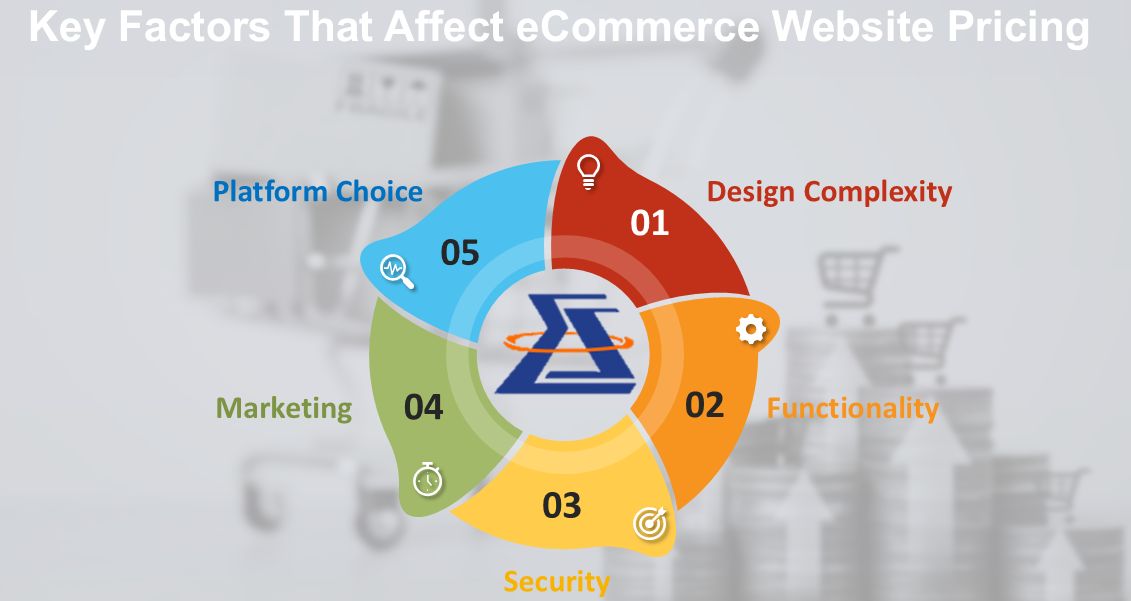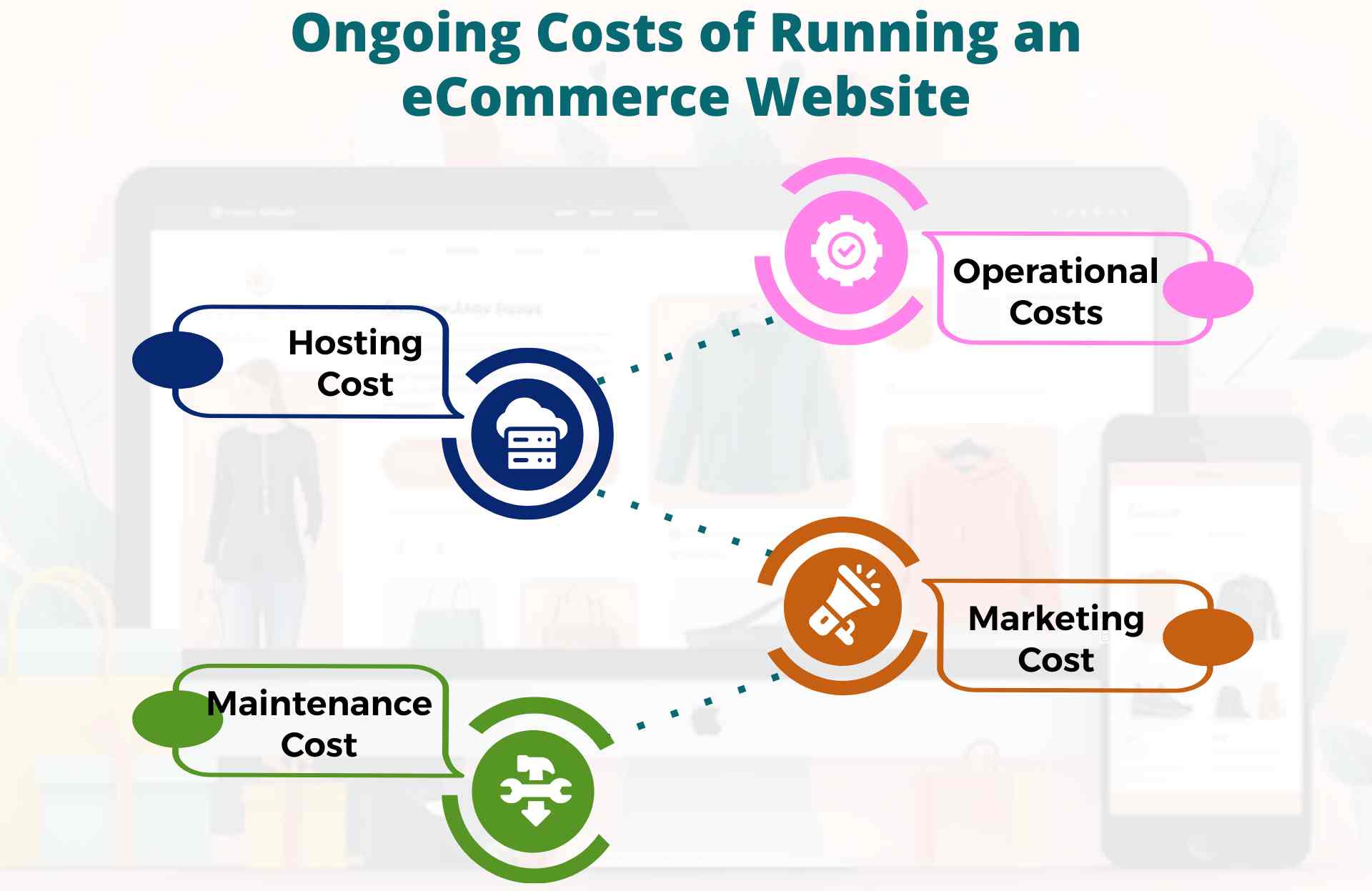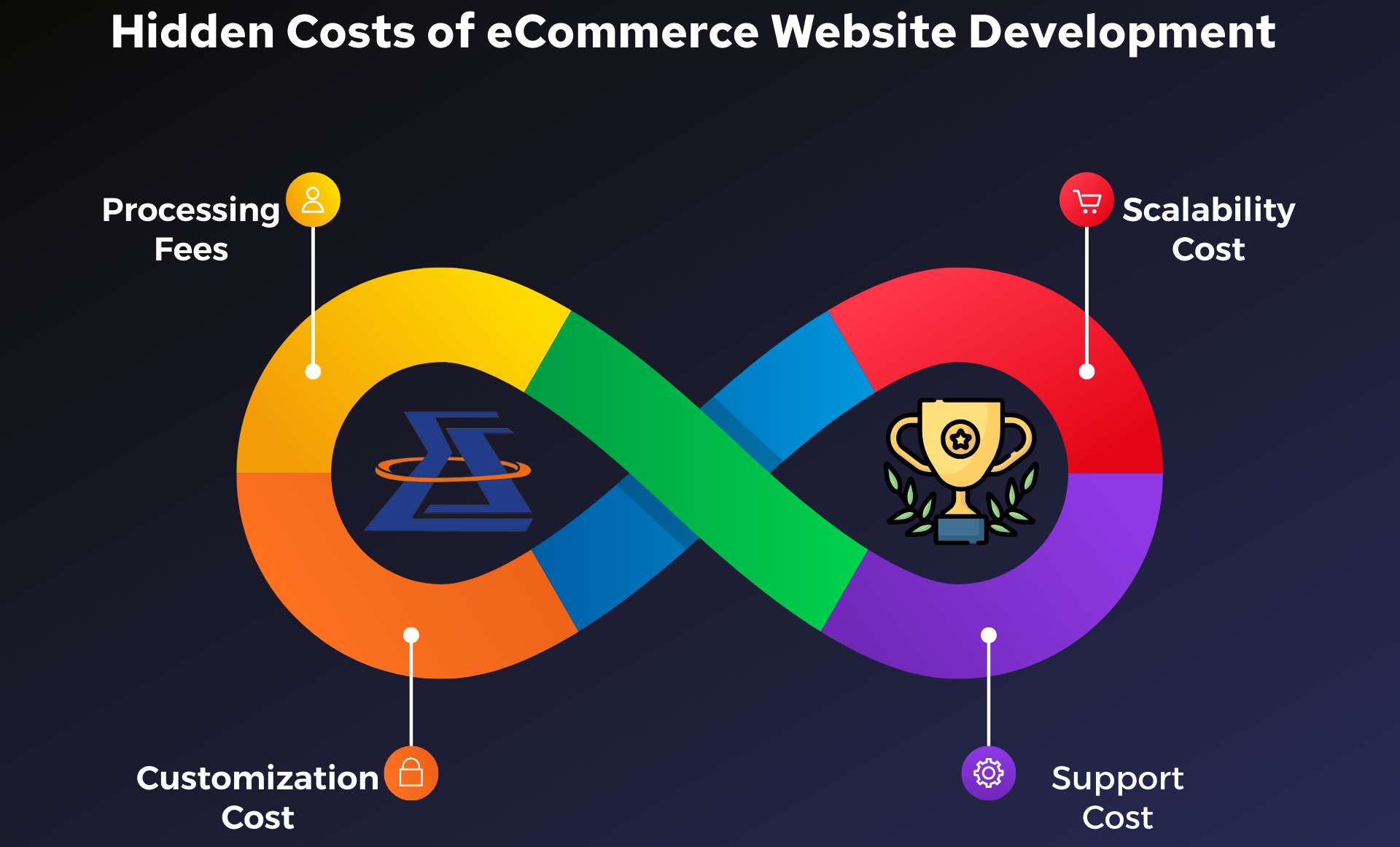Introduction
The Growing Importance of eCommerce in 2024
The world population exceeds 8 billion people, and 33% of them, 2.71 billion to be exact, are shopping online. The above data is very startling and indicates that people are gravitating towards using the internet and especially eCommerce.
Some of the questions that come to the minds of businesses exist in the context of eCommerce website development costs. With the actual cost of goods delivery, the greatest cost of an eCommerce website is steadily increasing. Ever since the COVID-19 pandemic hit the world, business organizations have awarded the importance of digital transformation. They are willing to embark on eCommerce website development, but the only hitch there is that they do not know how much does an eCommerce website costs.
Amid geopolitical tension in 2024, businesses need to have a full insight into eCommerce website pricing to assess the profit margin. To this end, Sigma Solve has devised this guide with the purpose of presenting businesses with a big picture of eCommerce website cost estimates.
Key eCommerce Statistics
The importance of eCommerce cannot be any longer in doubt today. eCommerce has been continuously on the rise around the world, especially in Asian emerging markets. Within this process, the eCommerce market will reach USD 6.3 billion in 2024.
Benefits of an Online Store
On an eCommerce website, you are accessible 24/7, you will have a global customer base extension, and growth is scalable. However, physical stores incur high overhead costs and require valuable customer data.
How Much Does an eCommerce Website Cost?
In most cases, eCommerce websites are developed as web pages specifically depending on the company’s requirements. Therefore, determining the exact eCommerce website development costs is akin to making a loss-worthy commitment for a website development company in the USA.
Broadly speaking, basic eCommerce website development costs may stay between $500 and $5000. However, the custom-built eCommerce website cost for big businesses may invite the expense of over $250000 with monthly fees.
In this blog, let us convey to you how various elements influence the cost of a custom eCommerce website. By the end of this blog, you will be able to upload something to your online store without much fuzzing over what it means to budget.
Key Factors That Affect eCommerce Website Pricing

Platform Choice
Your decision of the eCommerce platform significantly determines the cost, feature, and growth of your website. Popular options include:
Shopify
Shopify website pricing is a hosting solution enhanced by monthly subscription fees. They are suitable for businesses with approximately 100 employees and need fast implementation.
WooCommerce
It is an open-source WordPress plugin of high flexibility. Initially, it is free, but the WooCommerce pricing structure entails hosting, security, and extensions, which are crucial for the running of the business.
Magento
Magento has been embraced by larger companies since it offers features found in modern e-commerce and has a strong security system. As a result, Magento eCommerce costs are actually on the higher side.
BigCommerce
Like Shopify, BigCommerce provides great features and customization for larger and more popular businesses.
Design Complexity
Template vs. Custom Design
Custom designs tend to cost $5,000+, while premade themes cost $50-$200. However, they offer more unique branding and much higher eCommerce website development costs.
Impact on User Experience
400% more conversions are possible if carried out by a professional web designer. A well-developed site enhances the usability of the site to the user, hence more sales and more customer loyalty.
Functionality & Features
Basic vs. Advanced Features
These basic eCommerce features include product catalogs and checkout systems and cost $5,000-$15,000. Features such as personalized recommendations or multi-language support are great to increase the cost to between $50,000 and $250,000+.
Third-Party Integrations
On average, integrating payment gateways, such as PayPal and Stripe, shipping APIs, and marketing tools will cost $500–$5,000 per integration, based on the complexity and level of customization required.
SEO & Marketing Features
Search rankings become more critical through SEO-friendly architecture and mobile responsiveness. Adding these features can cost you around $2,000-$10,000 to your custom eCommerce website development costs, but are necessary to achieve long-term success.
Initial costs may rise to $1,000–$5,000, with ongoing costs for campaigns with other funding marketing tools such as Google Ads integration, SEO plugins, and email marketing.
Security & Compliance
The eCommerce security and compliance costs include SSL certificates at $50-$300 per year, PCI compliance measures at around $1,000-$10,000 per year, and regular security audits. Data breaches and fraud are protected by these costs, so your business and customers aren’t impacted.
Breaking Down the Costs: Small, Mid-Sized, and Enterprise eCommerce Sites
This report also compares the cost of an eCommerce website from the applications of the budget of the small or big business size and the requirements. Here’s a breakdown of typical eCommerce website pricing for different scales:
Small Business eCommerce Website
Finding affordable solutions like Shopify or WooCommerce is a common choice for owners of small businesses. These platforms come with great features and easy setup and incur eCommerce website design costs of about $5,000-$20,000.
Mid-Sized Business eCommerce Website
But for midsized businesses, one wants more of customisation, specific third-party integrations for eCommerce, and marketing tools. The eCommerce website cost within this category typically ranges between $20000 and $100000 for the simplicity and specific requirements.
Enterprise eCommerce Website
These systems exist for enterprise-level eCommerce sites and have required complex structures, high levels of customization, scalability, and multilingual support. Often, you’re starting at $100,000 and can go up towards the million-dollar territory for a fully custom, feature-complete platform.
Pricing Table: eCommerce Website Cost Comparison
| Aspect | Small Business | Mid-Sized Business | Enterprise Business |
|---|---|---|---|
| Design | $1,000 - $5,000 | $5,000 - $25,000 | $25,000 - $100,000+ |
| Development | $3,000 - $10,00 | $15,000 - $50,000 | $50,000 - $500,000+ |
| Hosting | $20 - $100/month | $100 - $500/month | $500 - $5,000+/month |
| Integrations | $500 - $2,000 | $2,000 - $10,000 | $10,000 - $100,000+ |
| Maintenance | $500 - $1,000/year | $1,000 - $5,000/year | $5,000 - $50,000+/year |
Off-the-Shelf vs. Custom-Built eCommerce Websites: Which Should You Choose?
Talking about the eCommerce website pricing, we at Sigma Solve focus on two different aspects. We can meet your needs using readymade website templates for eCommerce stores, or we can undertake a custom eCommerce website development that is uniquely aligned with your requirements and objectives.
Off-the-shelf (SaaS) Platforms
Pros:
- Lower upfront cost: Small businesses find that SaaS platforms have lower initial expenses.
- Fast setup: It has quick deployment capabilities, thus making businesses rapidly launch their online stores.
- Included hosting and security: SaaS solutions offer hosting and some security by default.
- Regular updates: Software updates are handled by the software platform providers, so you don’t need to spend any time keeping your site current.
- Community support: Resources, plugins, and good troubleshooting are offered by large user communities.
Cons:
- Limited scalability: However, if your business grows beyond the capabilities of the platform, you may find yourself at the point where you need to go through a costly migration.
- Ongoing subscription costs: Custom solution costs can exceed recurring fees of monthly or annual fees.
- Transaction fees: There are some platforms that charge a per transaction fee, which eats into profits as sales volume goes up.
Example: Shopify Pricing Model
They have tiered plans from $29 up to $299 a month, and then you’ve got some different people that would cost more or less depending on what add-ons you use.
Custom-Built Websites
Pros:
- Full control over design: Because custom solutions provide unique, brand-specific designs, they are able to stand out from the rest of the pack.
- Tailored functionality: You develop the features that exactly fit the needs and workflow of your business.
- Scalability: The good thing about these custom sites is that they can grow as your business grows and increase as the traffic and sales volumes increase.
- Integration flexibility: It seamlessly connects with any third-party service or internal system your business may need.
- Ownership: As you have complete control of your site’s code and data, you reduce vendor lock-in.
Cons:
- Higher development costs: There is also a significant investment required up front in design and development for custom solutions.
- Longer development time: Custom eCommerce website development takes a comparatively longer time to build a website, whereas setting up a SaaS platform can be done with ease.
- Ongoing maintenance responsibility: updates, security patches, and technical issues are your leadership.
Example: Custom-built Magento or WooCommerce Solutions
Businesses with specific requirements and expecting fast growth will greatly benefit from custom Magento or WooCommerce implementation. When there are particular needs that an off-the-shelf solution can’t fulfill, they’re worth the investment.
Ongoing Costs of Running an eCommerce Website
Building an eCommerce store is not a one-time investment, but businesses do require support from the technology partner and need to pay for the maintenance. Recurring costs cover these recurring costs to keep your online store running, secure, and competitive.

Domain Registration & Hosting
| Hosting Type | Price Range (per year) |
|---|---|
| Domain Registration | $10 - $50 |
| Shared Hosting | $50 - $200 |
| VPS Hosting | $200 - $1,200 |
| Cloud Hosting | $300 - $3,600 |
| Dedicated Hosting | $1,000 - $5,000+ |
Maintenance & Updates
Most of the time, your eCommerce website is developed using some software programs that require frequent maintenance, eliminate bugs, and provide security solutions. eCommerce website maintenance costs can be levied annually or as decided by both parties. There is no prefixed proforma to calculate such a cost, but usually, annual maintenance may cost between $5,000 and $20,000.
Marketing and SEO
This widely accepted realization leads us to the conclusive understanding: the key to eCommerce success is continuous marketing. Specific areas it contains are SEO of the eCommerce website, SEM and PPC ads, social media marketing, and email marketing.
The eCommerce website cost estimates reported here indicated that these activities cost a small business $500 to $5,000 a month, which makes it overcharging for spending up to 33% of income on utilities.
Additional Operational Costs
Add in these items for customer support tools (live chat software), CRM systems, and inventory management software. Operations cost is an overhead expense that occurs even if the business doesn’t do well on the ROI and profit front. It could start from $50 and may go beyond $500/month depending on the size of the eCommerce store.
Hidden Costs You Should Be Aware Of

Are there any hidden elements to eCommerce website design costs? Businesses should be mindful of these dollar-dumping expenses:
Payment Processing Fees
Payment gateways charge a fee per transaction. To give an example, Shopify Payments will charge 2.9% + $0.30 per transaction, while WooCommerce with Stripe has similar fees but sometimes offers volume discounts.
Shopify vs WooCommerce Fees Comparison
| Aspect | Shopify | WooCommerce |
|---|---|---|
| Platform Fee | $29 - $299/month | Free (WordPress hosting required) |
| Transaction Fee | 2.9% + $0.30 | Varies by the payment processor |
| Payment Gateway | Included | Additional cost (e.g., Stripe, PayPal) |
Scalability and Growth
As your business scales, you may find that you need to replace servers, migrate to a CDN or dedicated platform, or even reimagine the architecture as your business scale increases. For potential scaling costs, budget $5,000 to $50,000+ in dollars.
Custom Functionalities and Integrations
This is why adding cutting-edge features such as AI-powered recommendations or AR product visualization may truly matter to your eCommerce website price. These advanced integrations might cost you $10,000 to $100,000+ or more per each.
Support and Customer Service
The cost of staff and maintenance would be expected to cost $30,000 to $50,000 + per full-time employee per annum to establish and maintain an in-house customer service team. This could be from $0.70 to $2 per minute of support provided at a call center.
Choosing the Right eCommerce Development Partner
Choosing the right development partner will determine the cost of an eCommerce website and your eCommerce success. Consider these options and factors:
In-House Team vs Outsourcing
It offers direct control, but eCommerce website design cost and management responsibilities are included in building an in-house team. And sometimes, it’s cheaper and allows for the expertise of specific skills.
Onshore vs Offshore Development
Offshore developers from countries such as India or Ukraine can cost $25-$100 per hour, while U.S.-based agencies charge $100-$250 per hour. However, the U.S.-based agencies charge in the range of $100-$250 per hour. When making this decision, consider time zones, communication, & quality.
How to Choose the Right eCommerce Development Company
You want to be sure your eCommerce development partner does have experience, does have a certain way of communicating, gives accurate figures on eCommerce website cost estimates, and has the solutions for your needs. Here are the critical criteria to evaluate:
Portfolio: Think about how many of their past projects would be similar to eCommerce websites. Find your way to success in different industries.
Client testimonials: Look at reviews and case studies and find out how clients have been satisfied and how the agency has managed to deliver results on time and within budget.
Pricing transparency: Look for someone who quotes everything precisely and in detailed costs. Unusually low bids may disguise other costs.
Communication: Pick a team that regularly communicates. They should also be responsive and capable of explaining technical concepts clearly.
Post-launch support: Make sure that the agency you choose to build your site for will provide ongoing maintenance and support services to tackle problems and update your site after it goes live.
Questions to Ask Before Hiring a Developer
- What eCommerce platforms do you specialize in, and why do you recommend them?
- Can you break down costs for me, even if there are hidden expenses?
- What do you do to secure and comply with eCommerce websites?
- How do you support your clients after launch? How do you keep things up and running?
- Could you discuss some scalable eCommerce solutions you’ve created for scaling businesses?
Case Studies: Real-World Examples of eCommerce Website Costs
Small Business Case Study
A niche product retailer released a Shopify store with custom themes and a few integrations. Total cost: Setup and design: $7,500, Shopify Advanced plan at $79 per month.
Mid-Sized Business Case Study
A custom WooCommerce site with advanced inventory management along with CRM integration was chosen by a growing fashion brand. Total investment: $500/month for hosting and maintenance and $45,000 for development.
Enterprise Case Study
A global electronics manufacturer created a complex B2B Magento-based multilingual platform. Total cost: The initial development will cost us $350,000, and it will require spending $10,000 per month to host, protect, and improve it.
Key Takeaways
- A low SaaS eCommerce platform pricing helps small businesses launch new ventures far more effectively.
- Custom solutions that balance cost and scalability are of value for mid-sized companies.
- To run your business with full control and customization and without any connections to external companies, enterprise-level eCommerce will require an investment.
- Business size and complexity increase the ongoing costs of running an eCommerce site.
- It depends on your particular business needs, how fast you need to grow, and your budget.
Conclusion
Key Takeaways on eCommerce Website Costs
eCommerce website pricing varies greatly depending on business size, selected platform, design complexity, and features required. Basic setups are $5,000; enterprise solutions are $1 million+. The eCommerce website cost estimate should include both initial and ongoing.
Contact Us for a Custom Quote
Ready to start your launch for an eCommerce website? How much money do you plan on spending, and what’s necessary to get out of the online store? Contact Sigma Solve at +1 954-397-0800 to get a quote from an experienced team that suits your business needs. By working together, we will help you find your balance between eCommerce website development cost and functionality to craft an online store that will help you grow and be successful.
eCommerce Website Cost FAQs
Fees for an essential eCommerce website should be somewhere between $5,000 and $20,000, which should encompass eCommerce design cost, development cost, and a cost for certain basic features. Depending on which platform you choose and how much you sell, ongoing expenses will continue.
Continuing costs involve free hosting ($20-$500+/month), maintenance ($500-$5,000+/year), marketing ($500-$5,000+/month), and payment processing fees for eCommerce (2-3% per transaction). Costs vary depending on your business size and complexity.
An eCommerce website costs around $50/month, up to $2,000+ per month for size and complexity. It involves hosting, security updates, content management, and basic technical support.
To make eCommerce work, a lot of people choose a combination of WordPress WooCommerce or a basic Shopify plan as a process that’s a little bit cheaper than costly alternatives. Setup costs for as little as $500 and $30 to $100 per month in additional fees.
Secure payment gateways, high-quality product images, user-friendly navigation, and a streamlined checkout process should be your priorities. They have an enormous impact on user experience and conversion rate.


